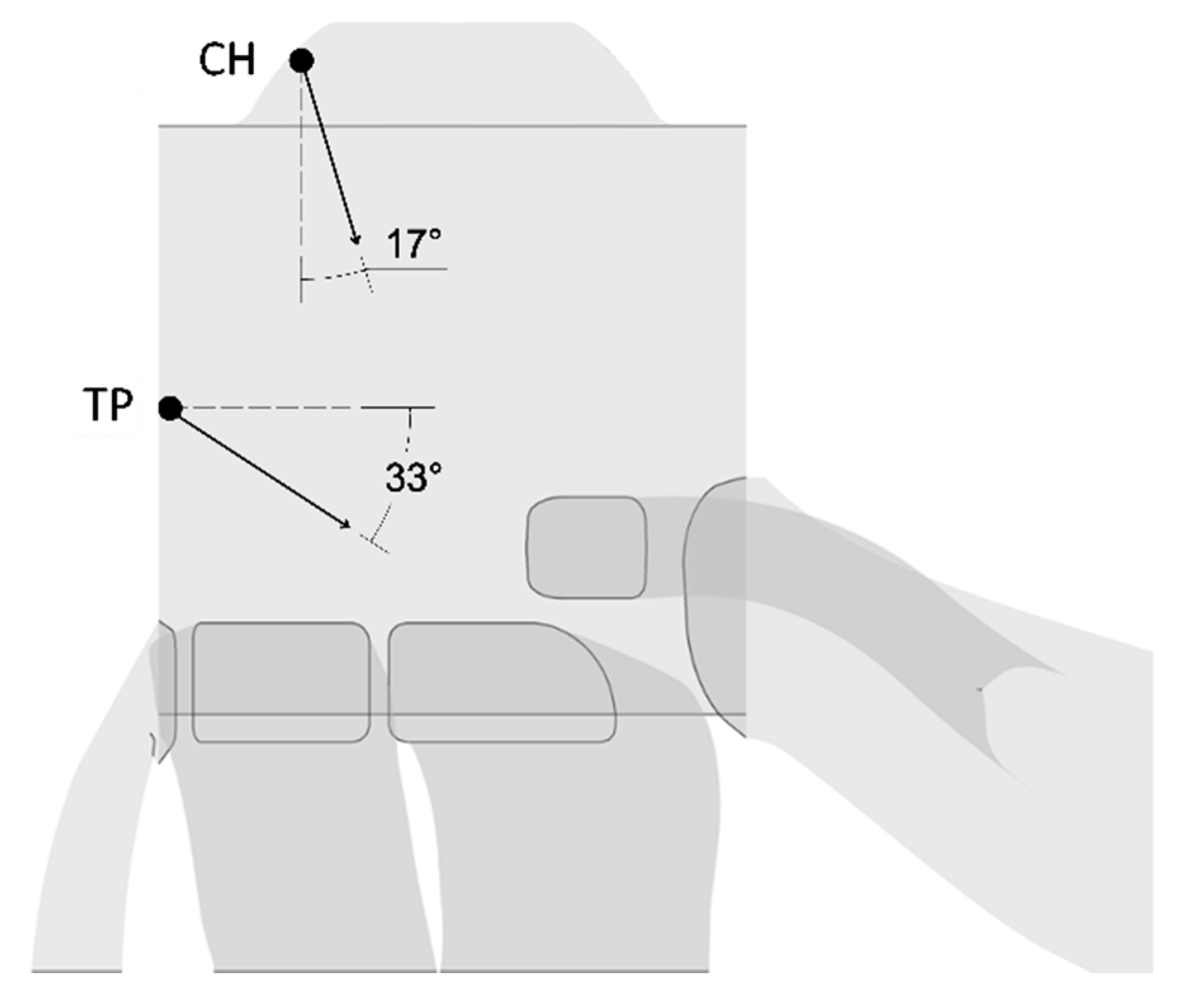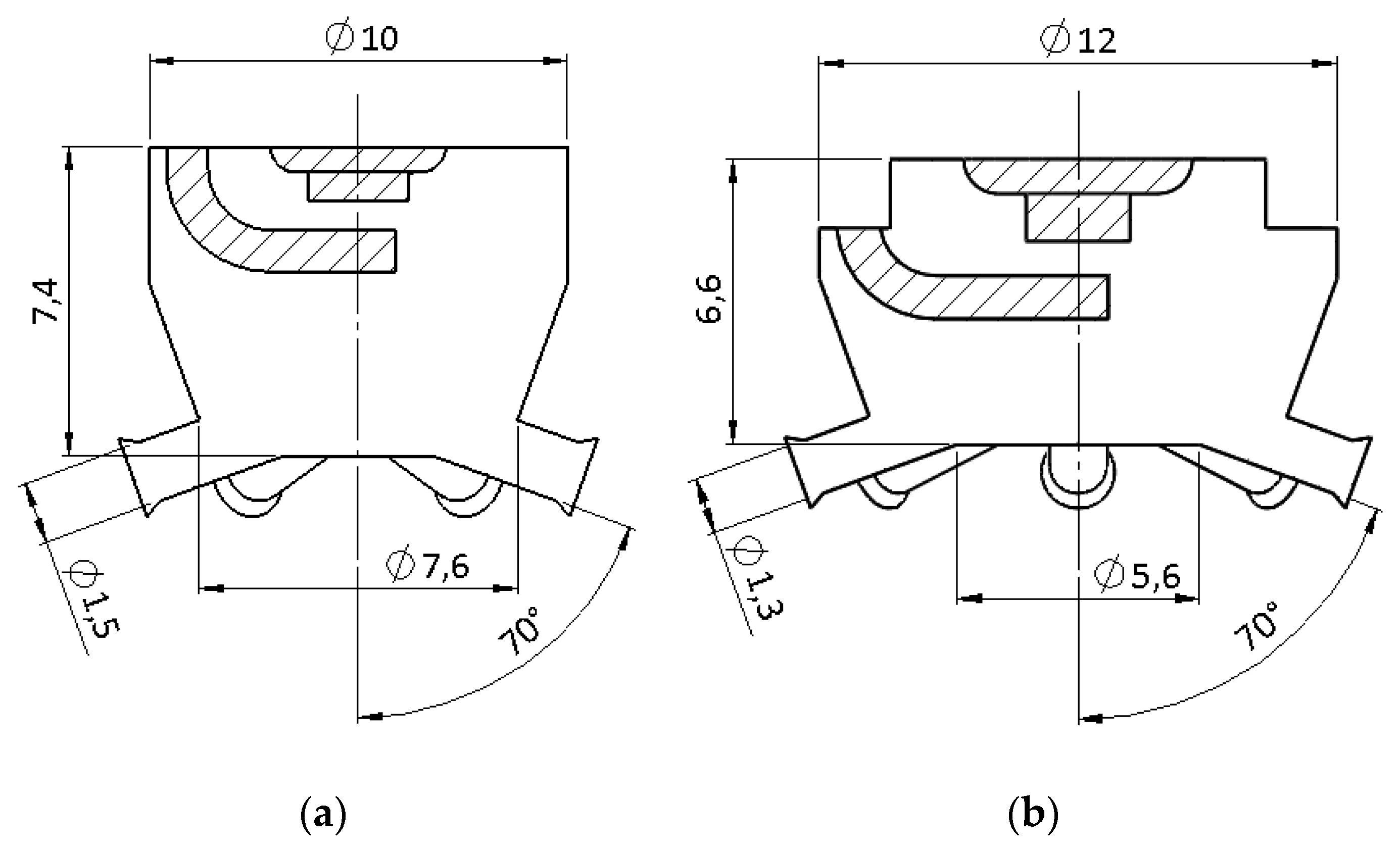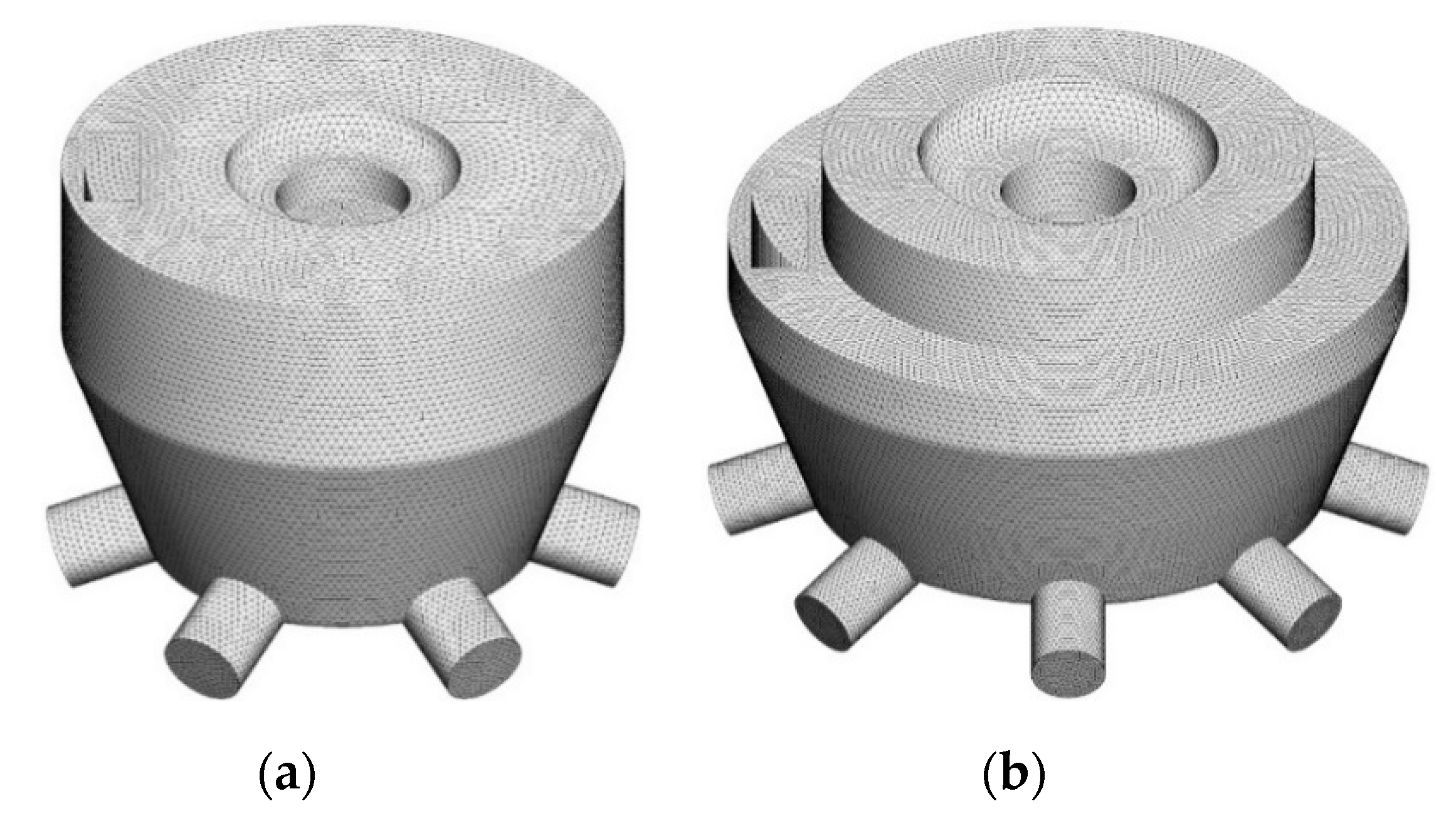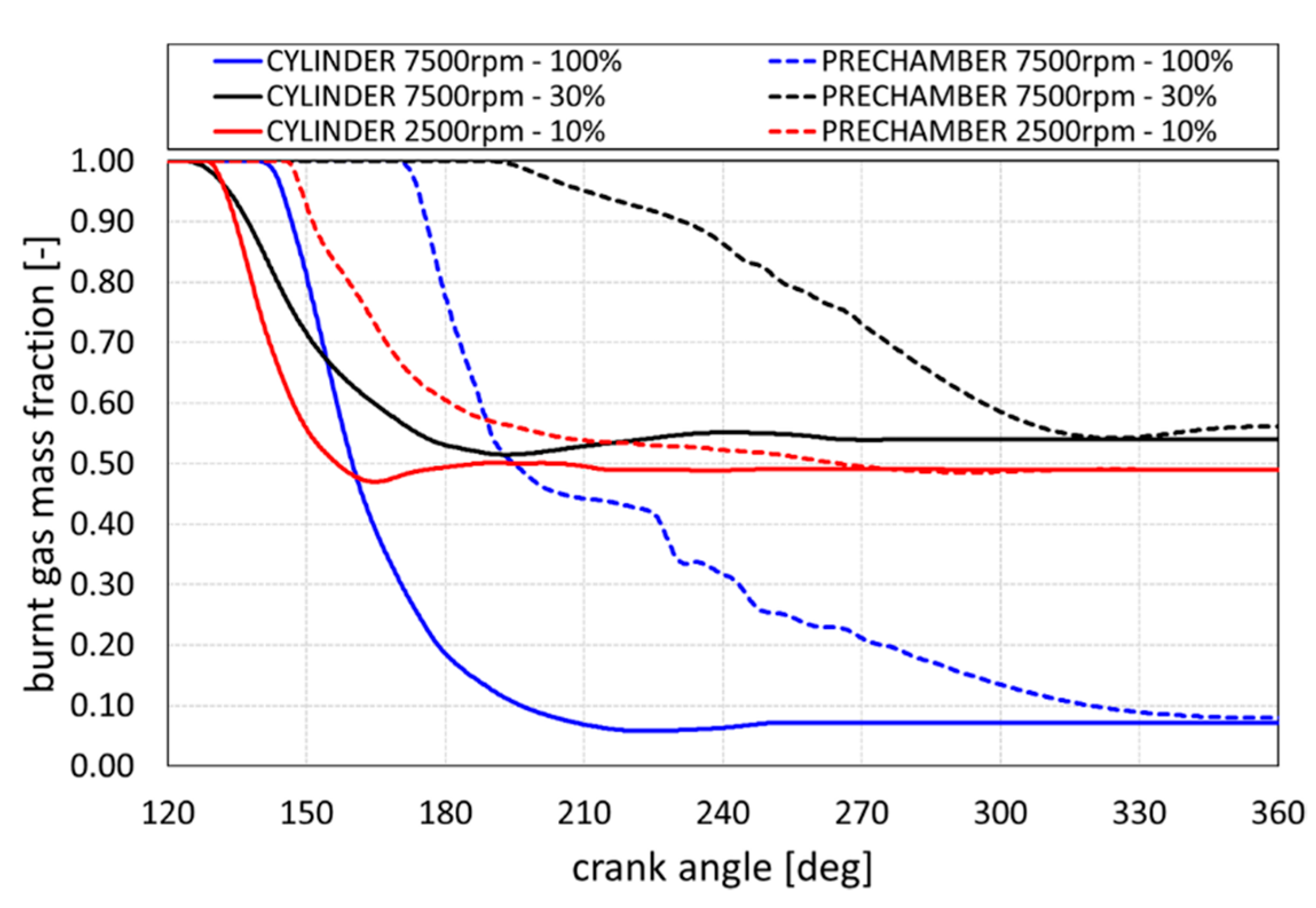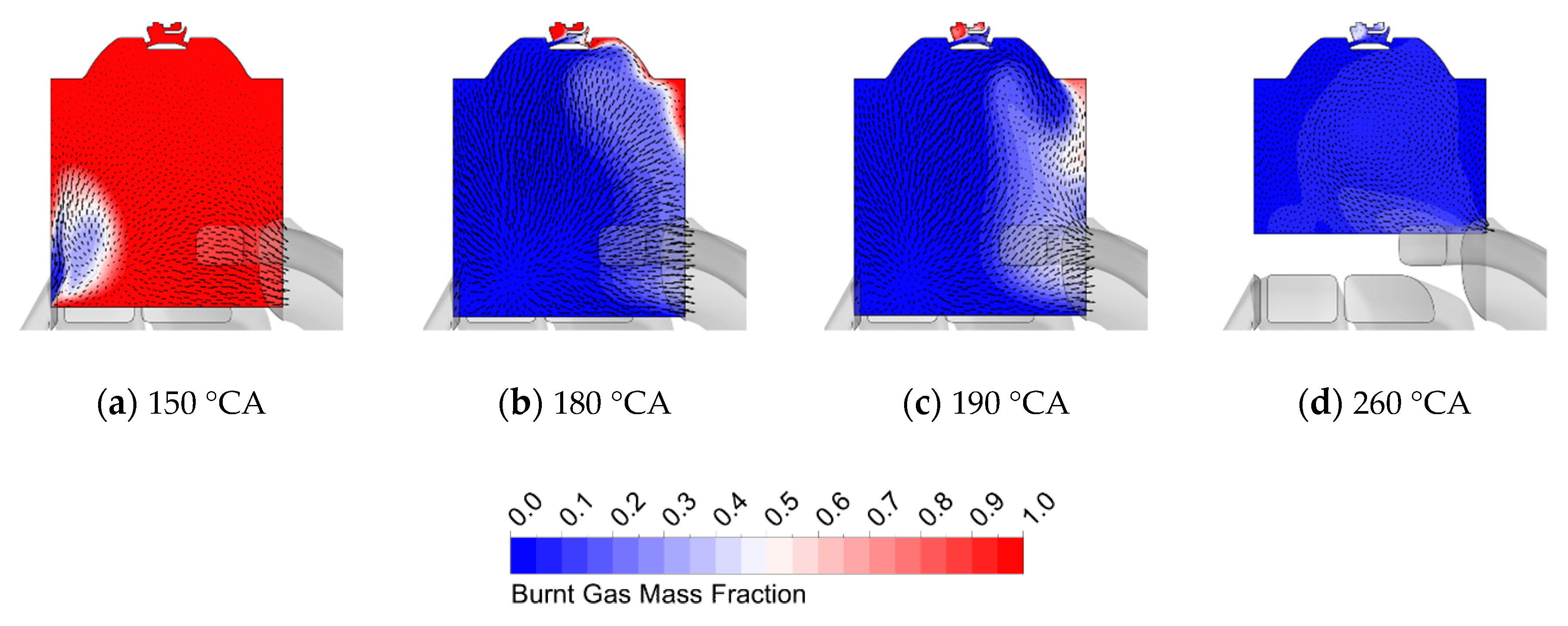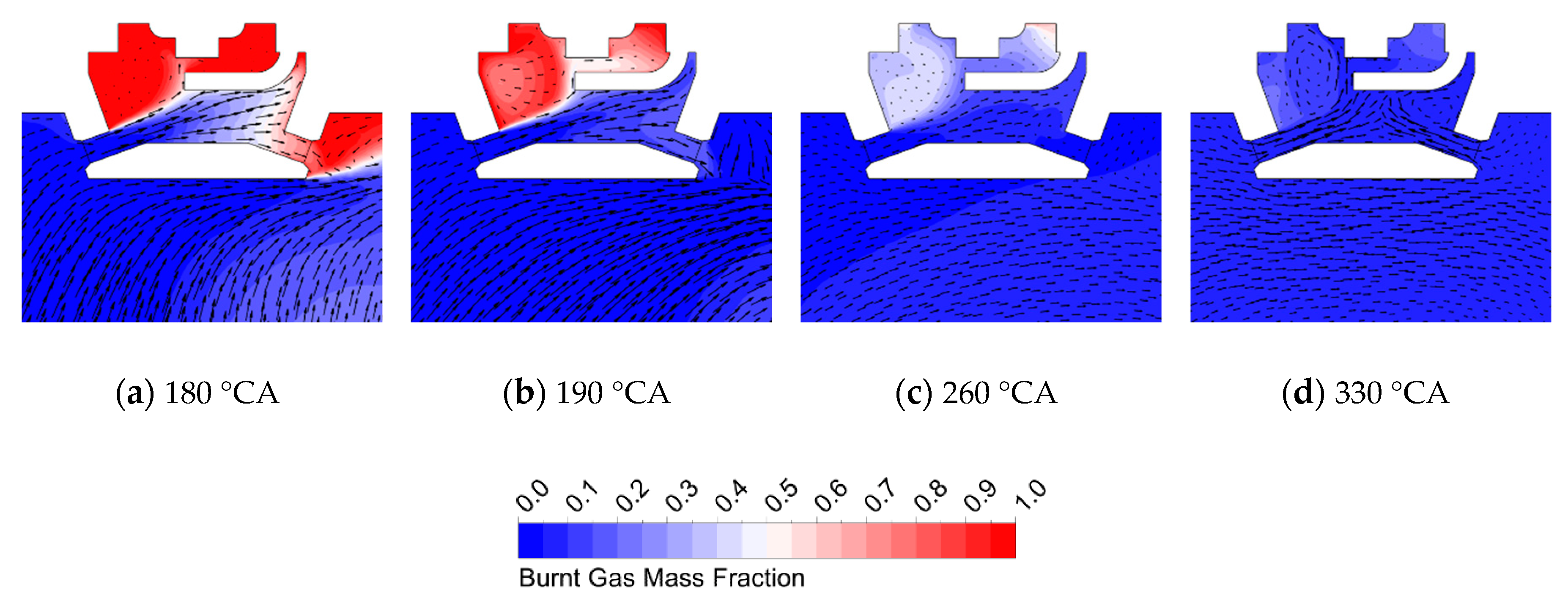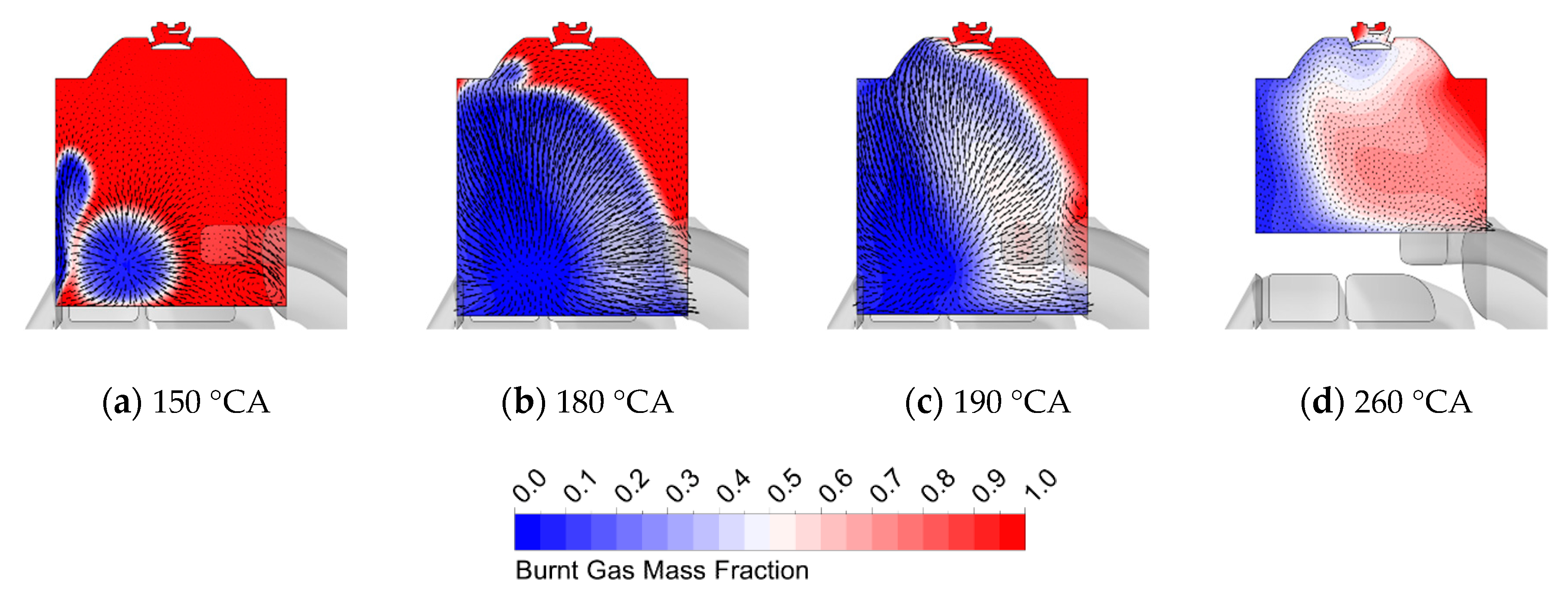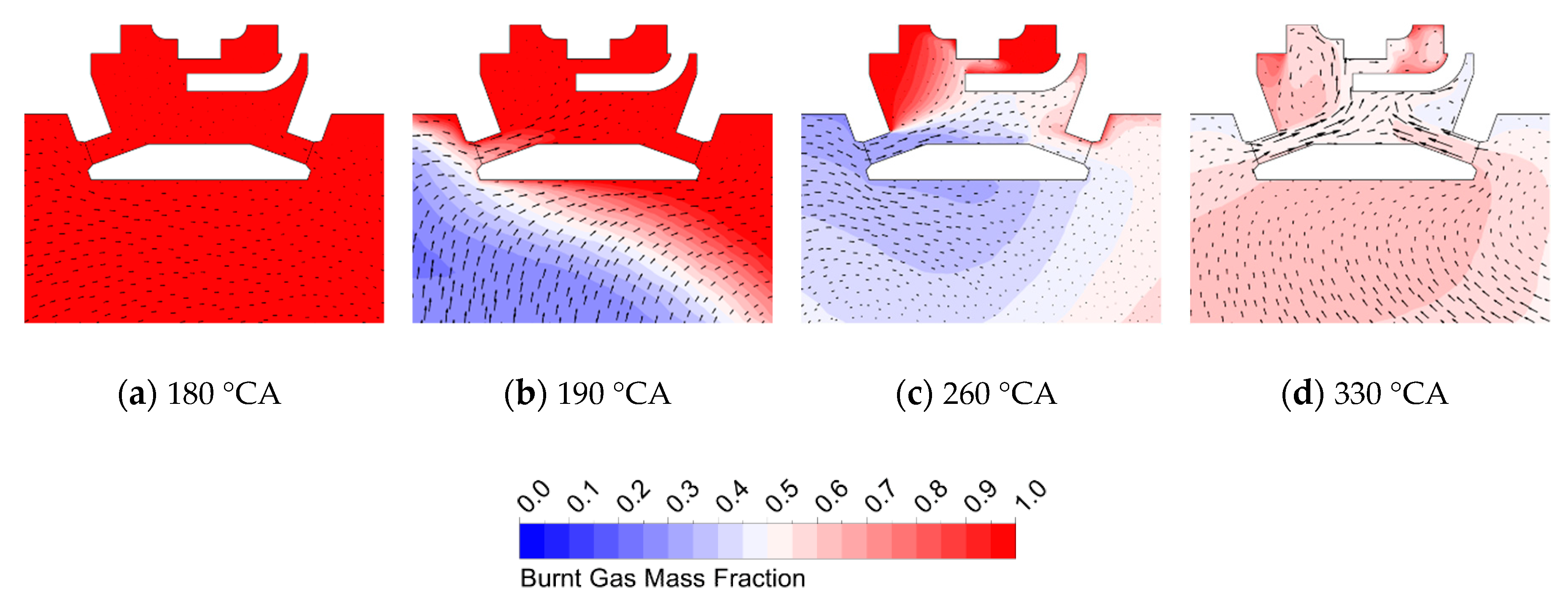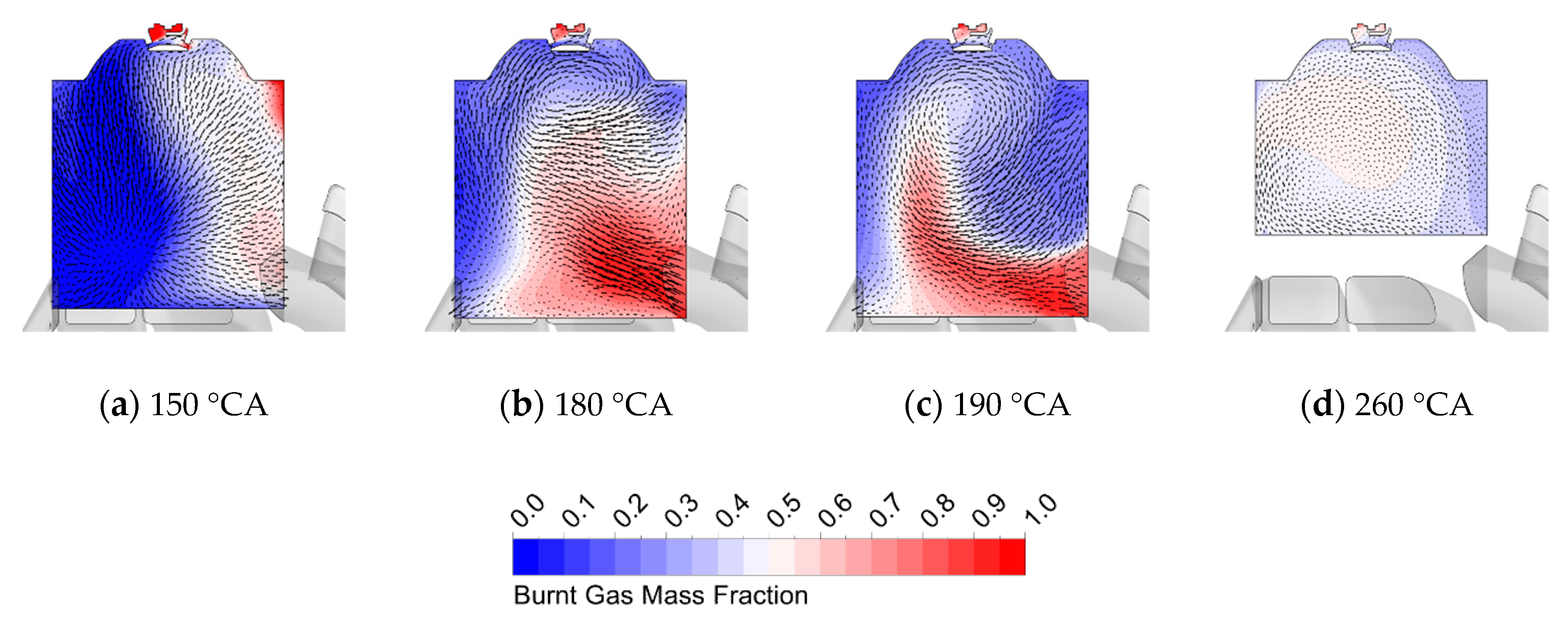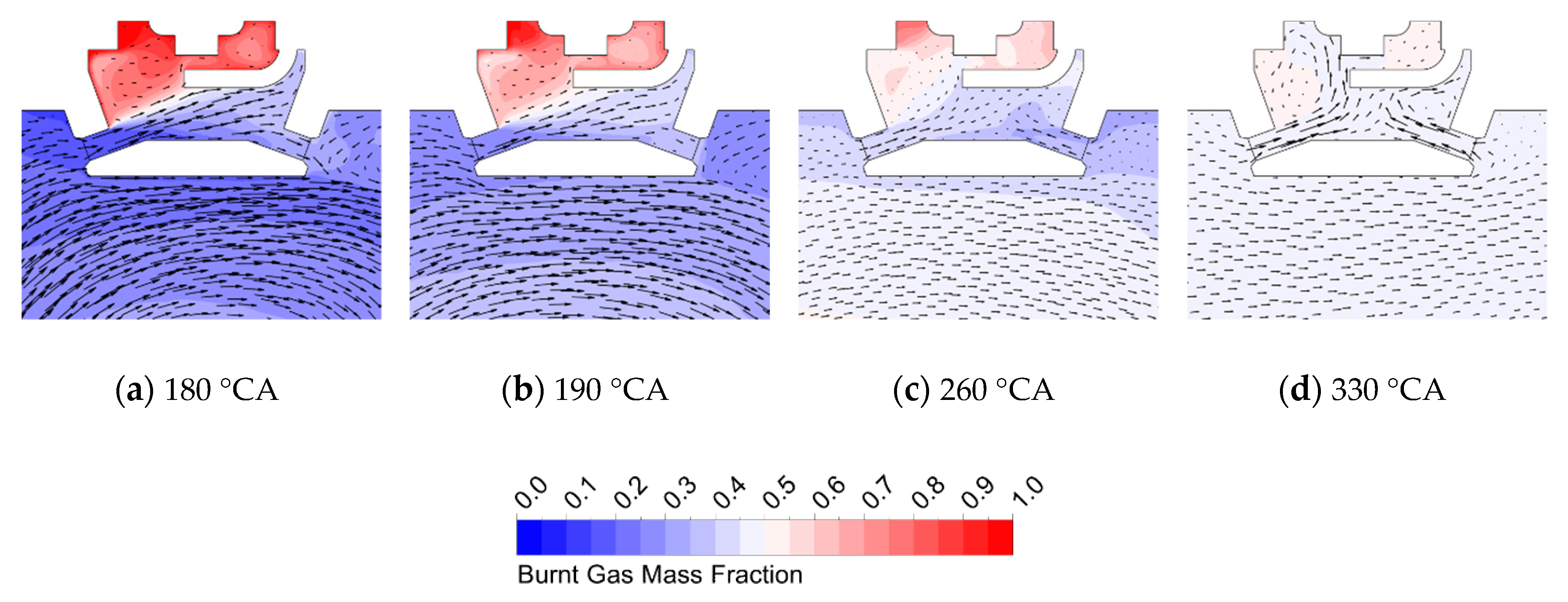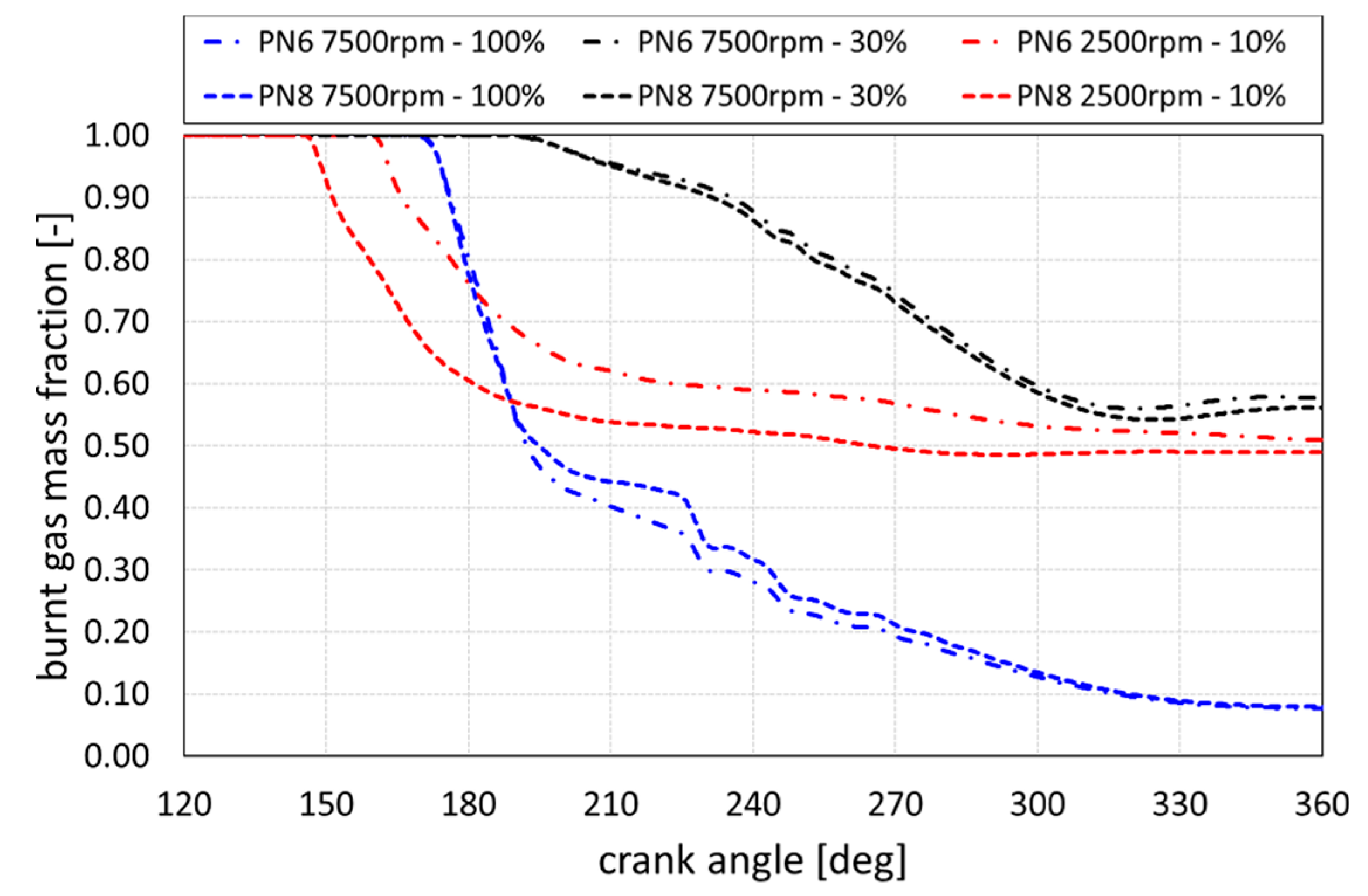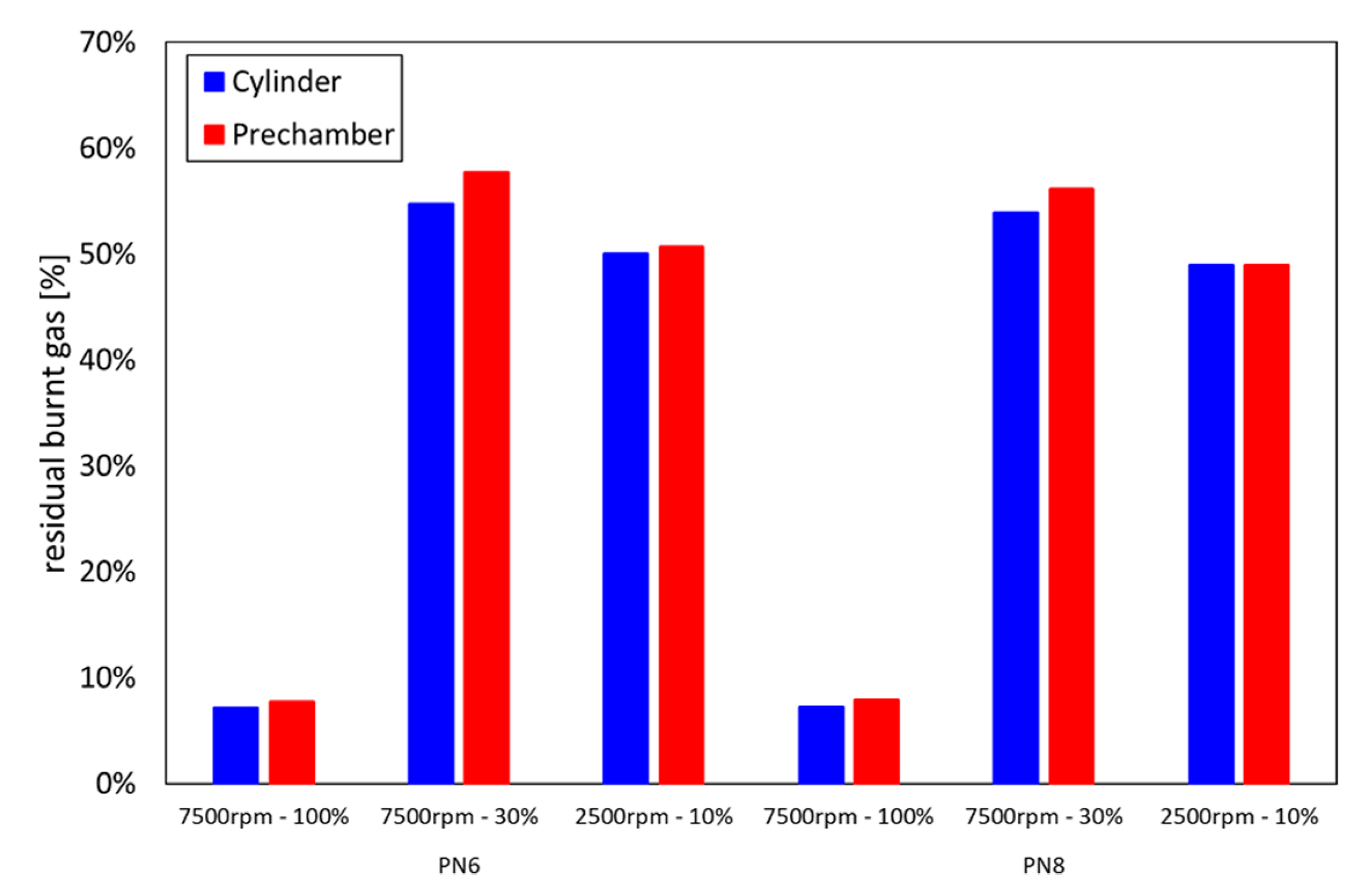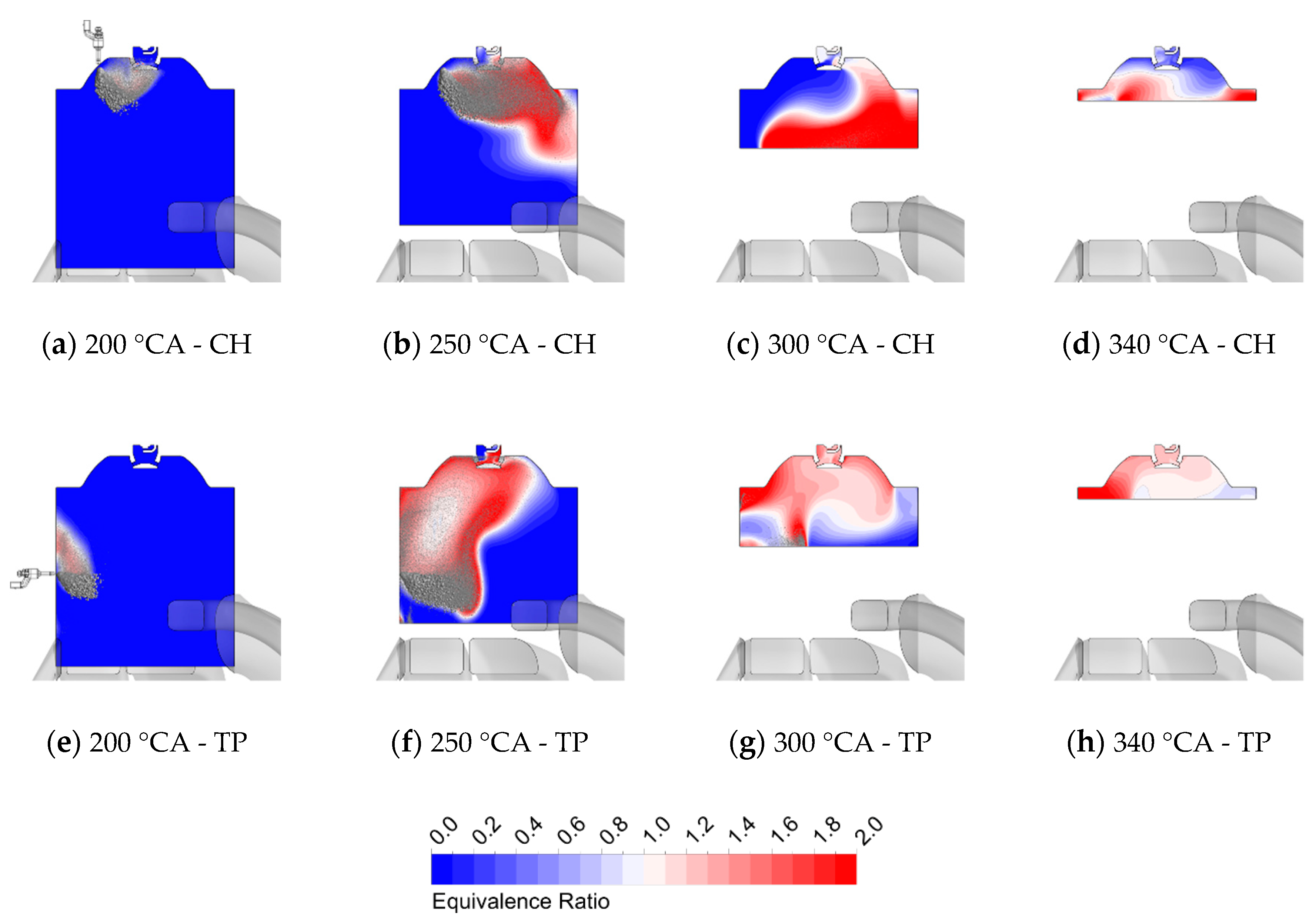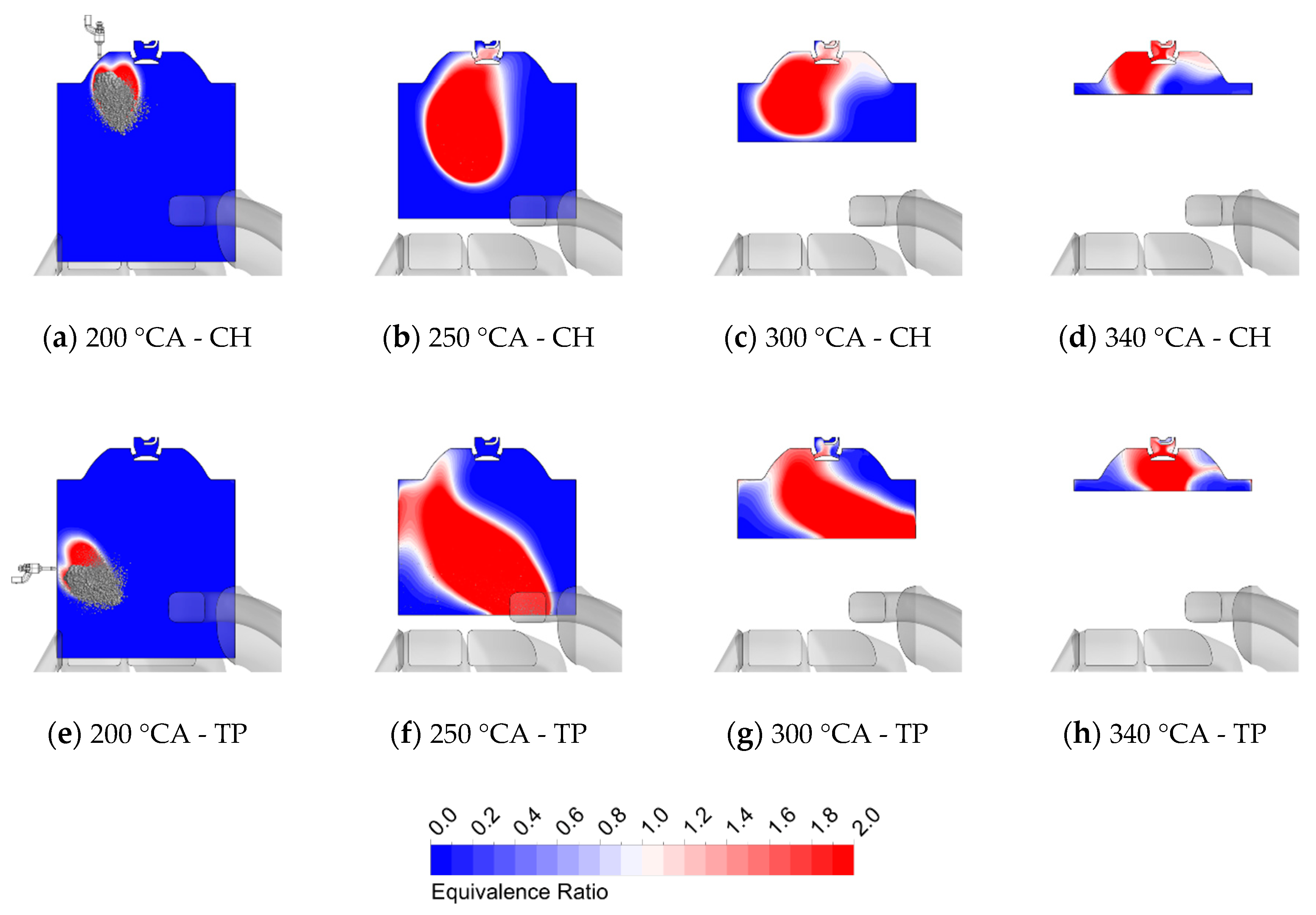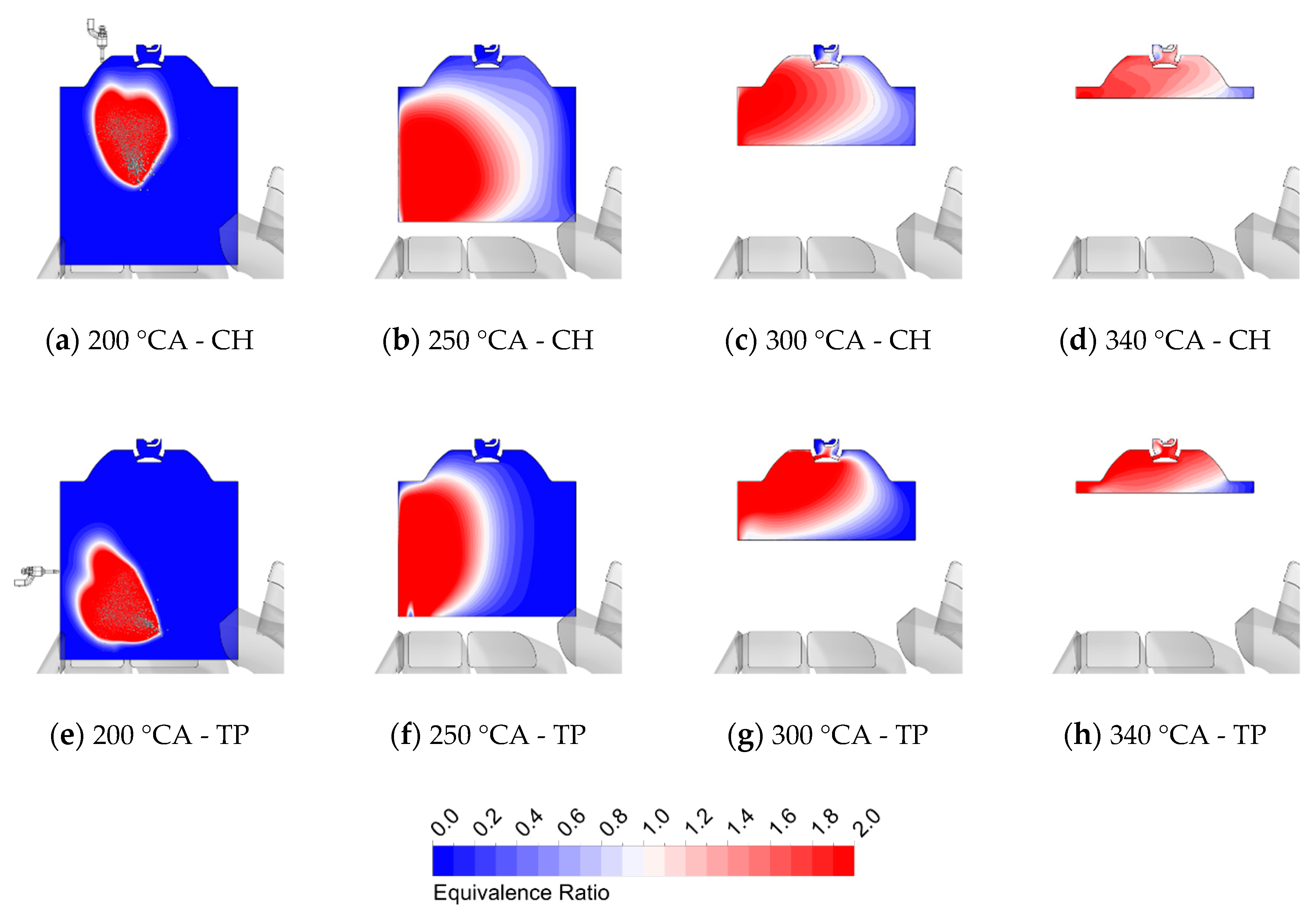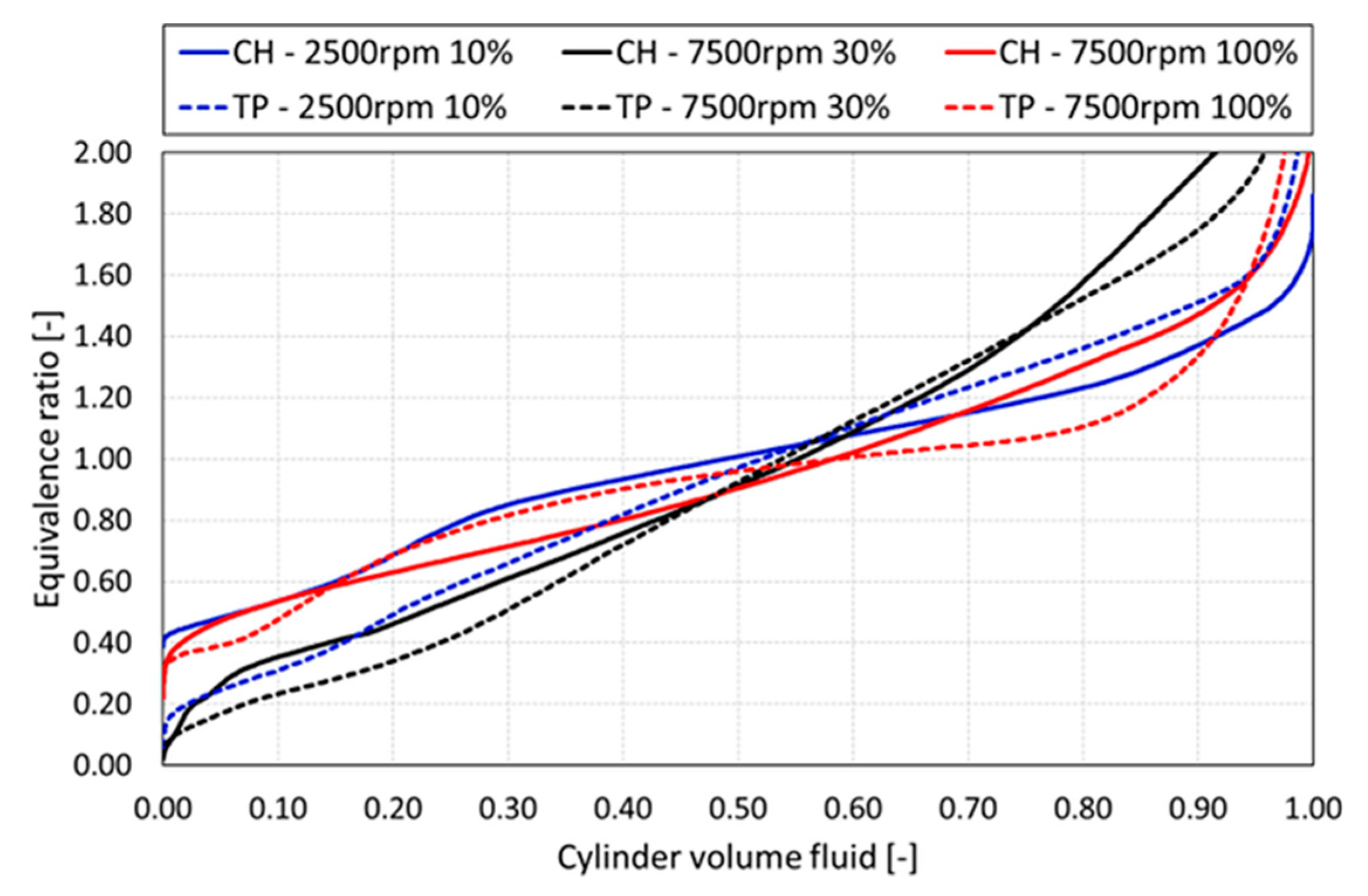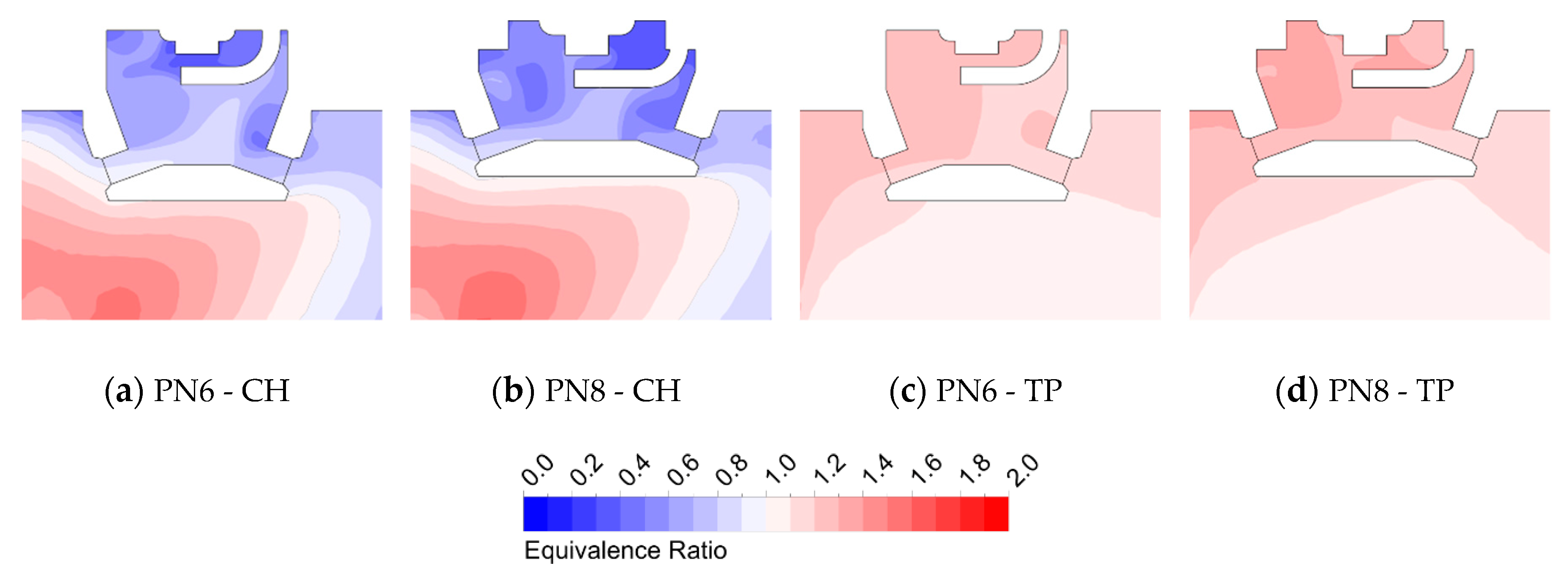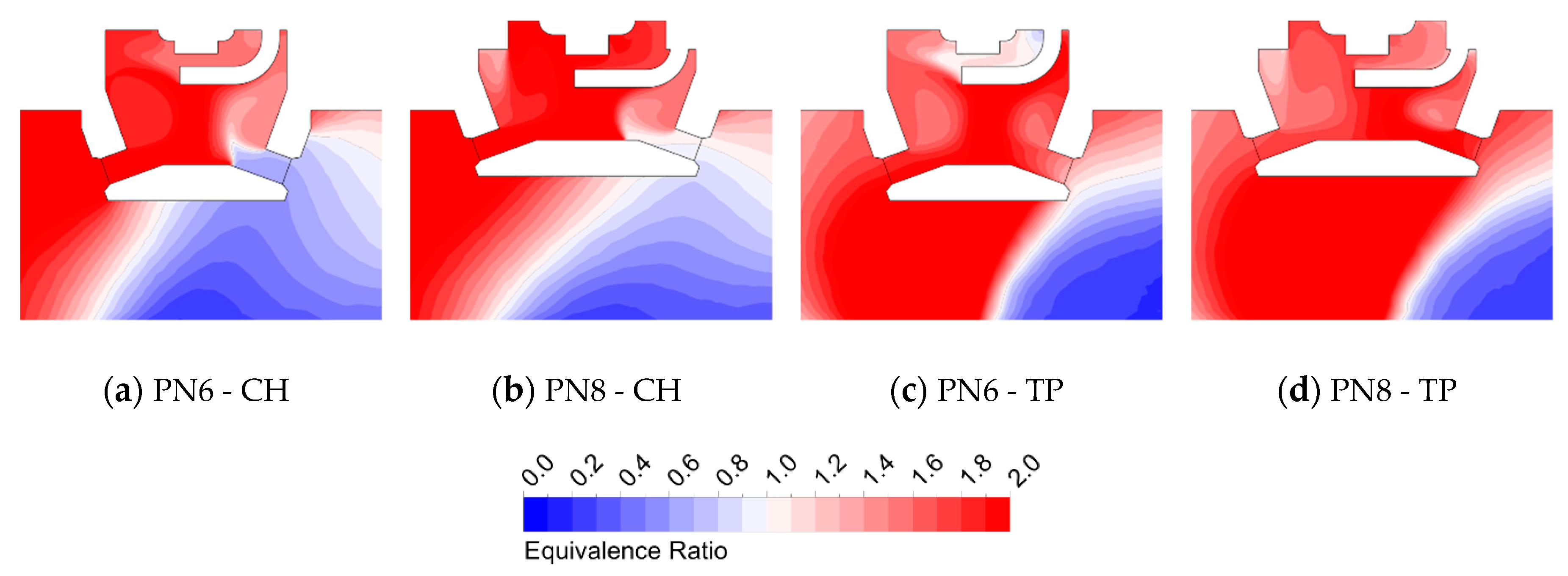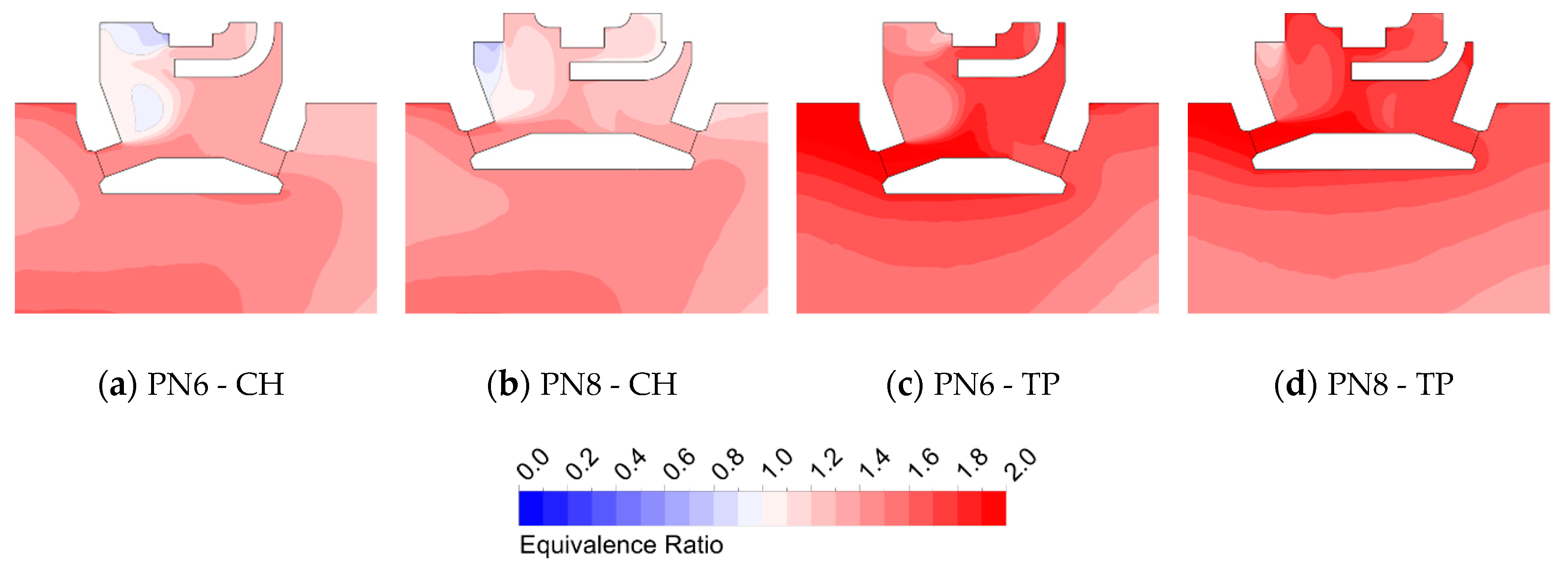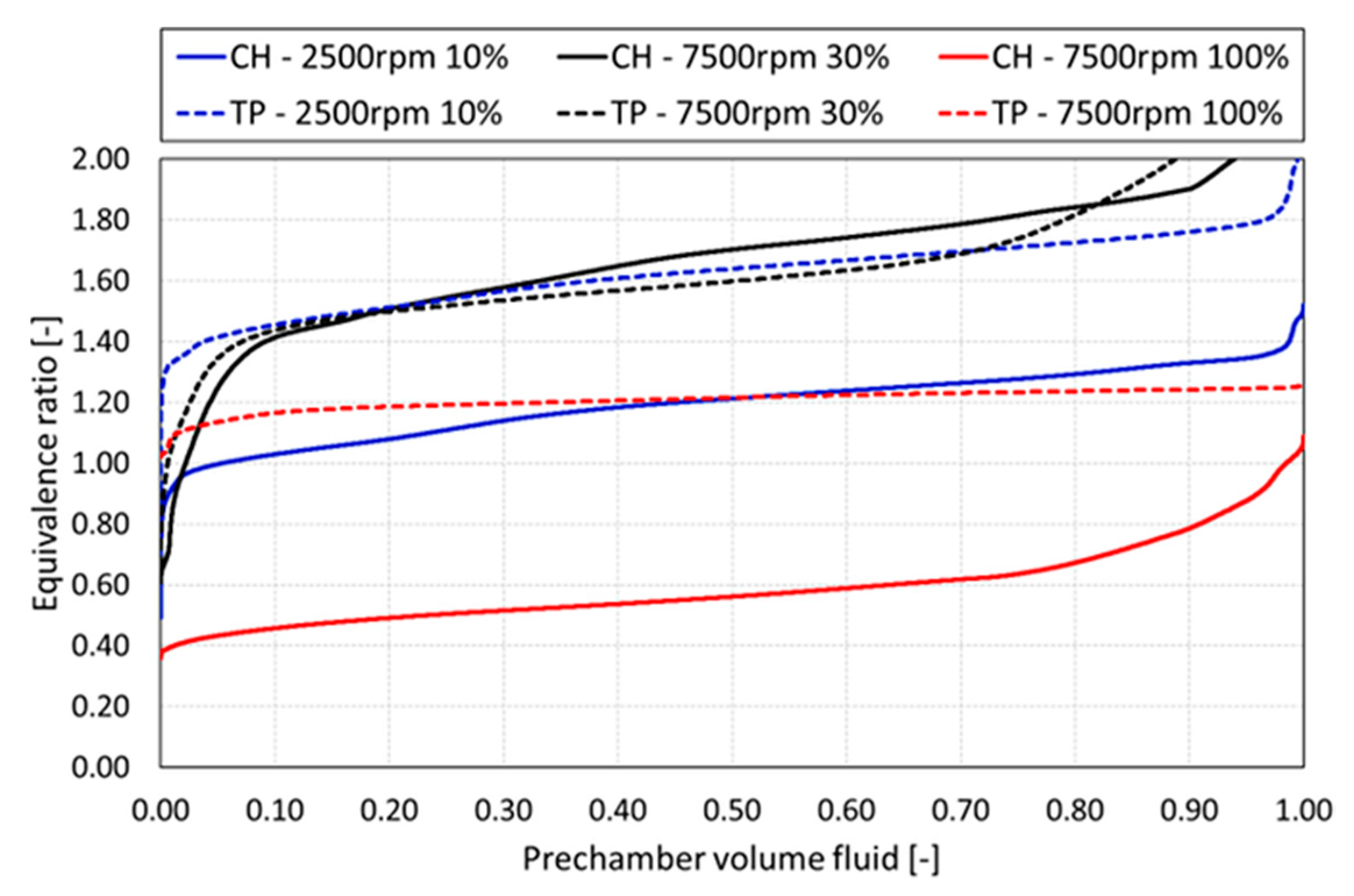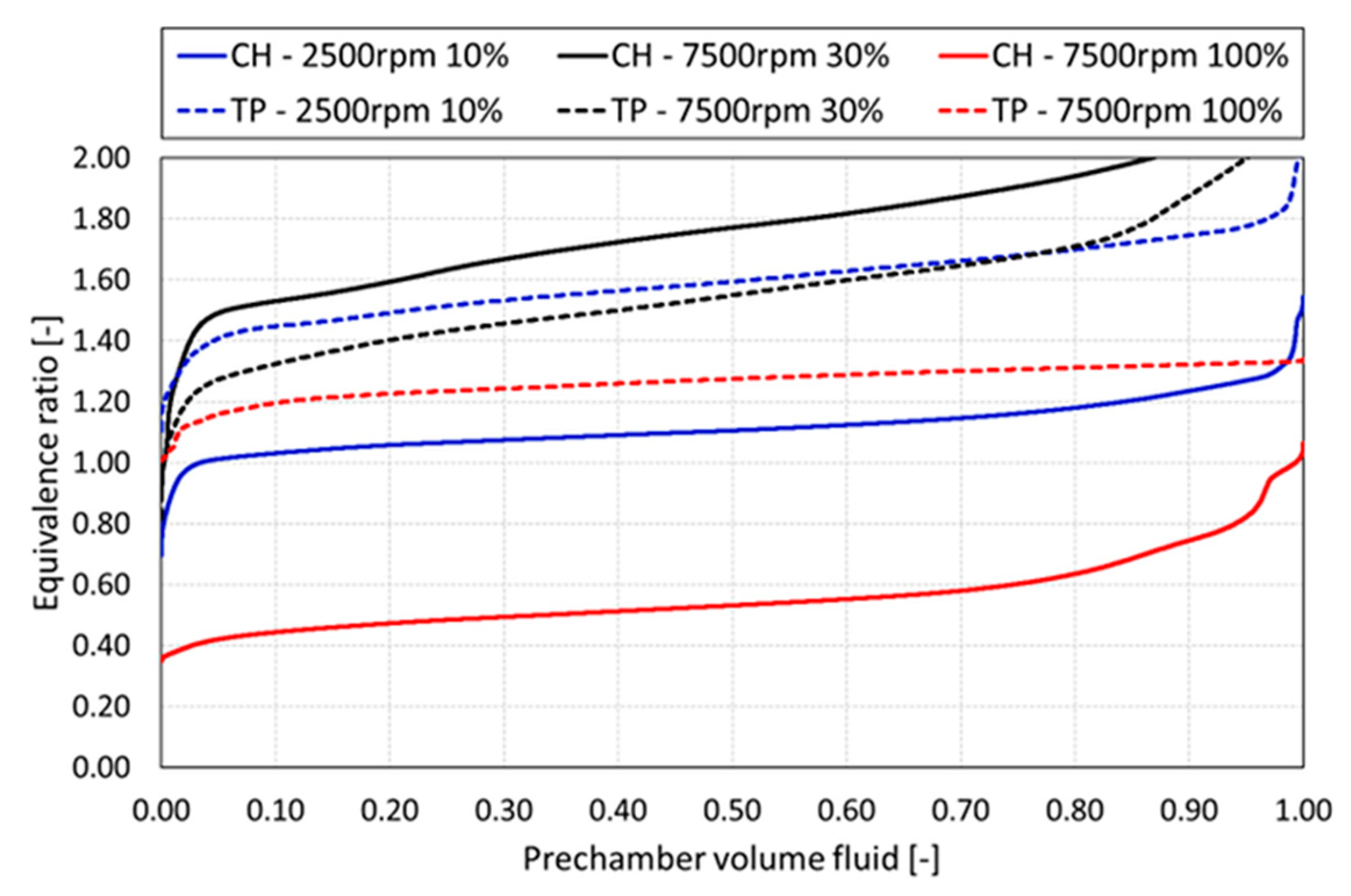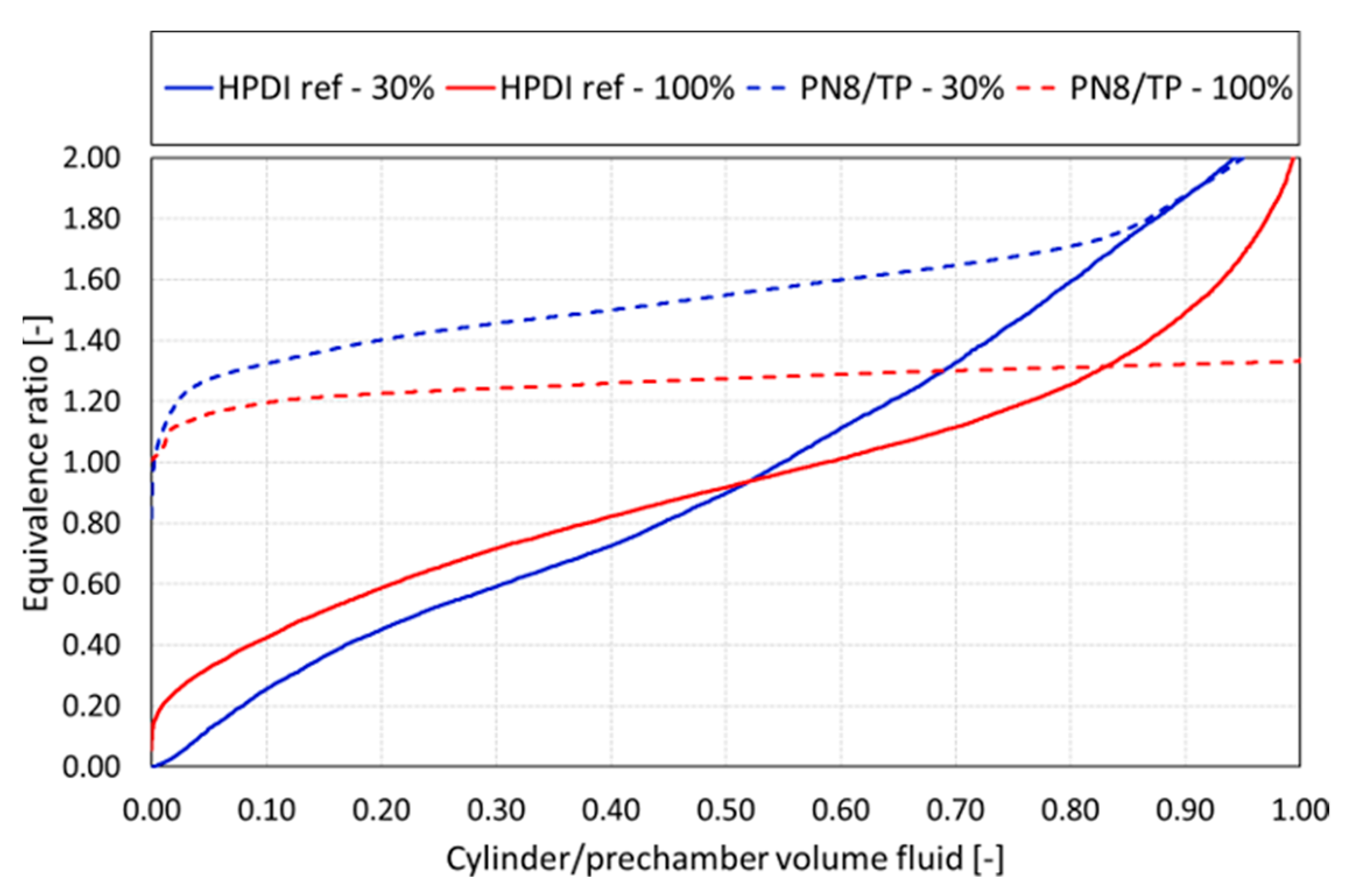1. Introduction
The position of two-stroke (2S) engines has been declining lately in automotive and motorbike applications due to the high values of both fuel consumption and unburnt hydrocarbons (UHCs) emissions. These issues arise from the scavenging process, which leads to the short circuit of fuel and lube oil, especially in non-tuned conditions, and to a high cycle-to-cycle variation at low loads [
1,
2]. However, high power density, light weight, low maintenance requirements, low complexity, and high reliability are typical features of 2S engines, which make them still well-suited for all those applications where the reduction of size and cost is crucial, e.g., hybrid propulsion, motorsport, and power tools. Gasoline direct injection (GDI) has the potential to solve short circuit issues, since it allows the introduction of the fuel separately from the scavenging air. Thus, the whole amount of injected fuel can potentially be trapped in the cylinder, while only fresh air is lost through the exhaust port during the scavenging process. Some of the authors have carried out several studies on a 300 cm
3 prototype showing the potential of direct injection strategies for a 2S engine, both from a numerical and an experimental point of view. The use of a low-pressure direct injection (LPDI) system allowed them to achieve a consistent reduction of both UHC emissions [
3] and brake-specific fuel consumption (BSFC) [
4], although insufficient fuel vaporization and fuel–air mixing may be found especially at intermediate rotating speed, which reduce the engine performance [
4]. Thus, care should be taken regarding the injection timing [
5] and the injector pressure [
6] in order to minimize these issues. High-pressure direct injection (HPDI) solutions allow achieving an extremely fast vaporization with a more stratified charge [
7] showing the potential of further improving UHC emissions [
8], in spite of an increase of cost and complexity of the system.
The sustainability of 2S engines may be further improved by adopting low temperature combustion techniques (LTC), which are studied massively in the automotive field because of the continuous development of the European legislation on pollutant emissions and the introduction of the WLTP (Worldwide Harmonized Light Vehicle Test Procedure) approval protocol [
9]. The LTC concept is based on the self-ignition of a premixed, ultra-lean, air–fuel mixture in order to reduce in-cylinder peak pressure and temperature. By doing so, it is possible to reduce the fuel consumption and the emissions of nitric oxides (NOx), as well as particulate matter (PM). However, LTC suffers from ignition instability, cycle-to-cycle variation, and in some cases, from the increase of carbon monoxide (CO) and UHC emissions [
10]. Different ignition concepts have been then developed to avoid these issues [
11].
Jet ignition (JI), also known as torch ignition (TI), is a very promising ignition technology to be used in LTC engines. JI makes use of a prechamber, i.e., an additional small combustion chamber in which the combustion starts, to generate hot turbulent jets capable of improving the combustion process inside the main chamber. The prechamber is located on the cylinder head and communicates with the main combustion chamber through one or more small orifices. The sparkplug ignites the mixture inside the prechamber, generating a flame front that propagates until it reaches the orifices. The hot turbulent jets exiting from the orifices in turn generate turbulent phenomena of heat and mass transfer inside the main chamber. As a result, a faster the combustion process is obtained, thus increasing the system efficiency, and reducing the unburnt products. An additional benefit is the increased capability of igniting fuel-lean mixtures inside the main combustion chamber.
There are mainly two ways to perform JI, which differ in the process of mixture preparation inside the prechamber. In the simplest case, namely “passive” prechamber, the fuel enters the prechamber coming from the combustion chamber (
Figure 1a).
In the automotive field, this technology has been widely investigated in indirect-injection engines from several manufacturers, e.g., Toyota [
12,
13], Robert Bosch GmbH [
14], Ford [
15,
16], and Suzuki [
17]. Literature studies claimed that the combustion duration can be more than halved depending on prechamber shape and geometrical features [
18], as a consequence of the drastic increase of the heat release rate (HRR) [
17]. Single-orifice setups were found to be effective in reducing the 0–10% mass of fuel burnt (MFB) duration, while multiple orifices showed a higher decrease of the 10–90% MFB duration [
18,
19]. Bigger volumes and smaller orifices were found to improve the momentum of turbulent jets, which increases the ignition induction period, causing the combustion in the main chamber to be more explosive [
20]. In particular, it was found that high-speed flame jets spouting into the main chamber cannot propagate to the mixture downstream of the orifice, as flame quenching occurs [
12], and ignition in the combustion chamber takes place due to the increase of in-cylinder turbulence and the high quantities of hydrogen, OH-radicals, and other partially burnt substances contained in the hot jets, which serve as a core for the subsequent chain reactions [
20]. Details on the ignition process can be found in [
20], in which four different ignition mechanisms were classified depending on the strength of turbulent jets. Studies have also shown benefits in terms of NOx [
13,
15], UHC [
14,
15], and CO [
21,
22] emissions, as a result of the improved combustion efficiency, which may lead to the decrease of the brake-specific fuel consumption [
14,
22].
However, the improvement of the combustion process and the increase of the peak pressure do not necessarily result in higher IMEP values, as the introduction of the prechamber may increase the clearance volume [
21]. Excessive thermal losses may occur, due to the impingement of jets on cylinder and piston walls [
18] or even the in-cylinder pressure may decrease too early in the expansion phase as a result of the lamination losses across orifices [
17]. Furthermore, even if the higher turbulence and the slower flow field in the prechamber slightly extend the lean flammability limit [
12,
23], passive prechambers showed a too high cycle-to-cycle variation in PFI fuel-lean engines [
22].
In order to increase the lean flammability limit, in-cylinder GDI strategies can be used to achieve different fuel-to-air ratios inside the prechamber and the main chamber. In fact, through GDI it is possible to obtain a rich mixture inside the prechamber, while keeping the mixture inside the cylinder very lean. Multiple injections [
24] and/or a proper piston bowl shape [
25,
26,
27] may be used to achieve this goal. The use of GDI systems reduces cycle-to-cycle variation and allows one to increase the air-to-fuel ratio in the combustion chamber, reducing further NOx and fuel consumption [
27,
28]. Since the setup of GDI solutions for passive prechambers is difficult and time-consuming, “active” (or “stratified”) prechambers have been developed. Active prechambers are equipped with a dedicated fueling system, which can be a valve, as proposed by Honda [
29] and General Motors [
30], or an injector, as proposed instead by Volkswagen [
31], Porsche [
32], and more recently by MAHLE [
33,
34,
35,
36].
Figure 1b shows the conceptual drawing of an active prechamber fueled by a dedicated injector. The concept of the active prechamber was born to further improve the engine operating range toward ultra-fuel-lean mixtures, achieving a stable combustion process up to lambda values higher than two [
34], a 20% higher fuel economy than conventional SI engines [
35], and extending knock limit when using low-octane fuels [
37], even if it implies a significant increase of cost and system complexity.
Although JI has been widely studied in four-stroke (4S) engines, only few works are available concerning 2S ones. In particular, the passive prechamber was studied for a small carburetor 2S engine [
17], while the use of GDI solutions was evaluated only in active prechambers [
38,
39]; conversely, to the best of authors’ knowledge, the use of passive prechambers in GDI 2S engines has not been considered so far. This is probably due to the lack of GDI systems for 2S engines on the market, which have gained interest only in the last few years.
The adoption of passive prechambers may be beneficial for 2S direct-injection engines without increasing the system complexity; however, the injection system must be carefully designed to obtain an adequate fuel distribution inside the two chambers. Furthermore, a suitable scavenge of the prechamber volume must be ensured to avoid misfiring. The present work thereby is aimed at investigating the preliminary design of passive prechambers to be used in a 300 cm3 HPDI crank-scavenged 2S engine. Unsteady three-dimensional computational fluid dynamics (CFD) simulations were carried out to analyze the flow field inside the prechamber for two geometrical configurations in three engine operating conditions. The simulations involved the analysis of the scavenging and compression phases to evaluate the capability of achieving a low trapped residuals fraction inside the prechamber, as well as the capability of filling the prechamber with fresh air and fuel. The combustion process is not investigated since the reliability of a CFD simulation in predicting the complex chemical reactions of a JI combustion process, without a robust set of experimental data for validation, is very poor. Notwithstanding this aspect, the adopted approach allows evaluating the effect of both the direct injection strategy and the preliminary sizing of the prechamber on achieving a proper mixture formation inside the prechamber. Therefore, the uniformity, the air-to-fuel ratio of the mixture, and the residuals fraction inside the prechamber were estimated and discussed, since they represent the major issues regarding the actual ignitability of the fresh charge for these passive devices.
4. Conclusions
The study discussed the feasibility of applying a passive prechamber on a HPDI 2S engine trough CFD analysis. After a thorough literature review on existing design guidelines for passive prechambers, two specimens have been designed in order to investigate the influence of the prechamber geometry on both the residuals and fresh fuel distributions. The effect of two injection strategies has been evaluated by changing the injector location. Three engine operating conditions have been considered.
The analysis on the behavior of the residuals showed a suitable scavenging process inside the prechamber, since the average MFBG inside the prechambers was almost equivalent to the main chamber at TDC. The prechamber with eight orifices (PN8) showed the best performance, with a slightly lower amount of trapped residual gases at partial loads thanks to its lower height-to-diameter ratio.
After confirming the ignitability in terms of residuals, the injection process was evaluated. Comparing the two injection strategies, it can be claimed that an injector location on the cylinder liner close to the fifth transfer port ensured the mixture ignitability at all the three operating conditions with acceptable fuel short circuit values, especially if compared to values of standard carburetor engines. In fact, the TP injection leads to a more relevant interaction between fuel and airflow, an increased diffusion of liquid fuel and a better fuel–air mixing. On the contrary, when the injector is located in the cylinder head, the spray diffusion and the mixing with fresh air is poorer, since the injection point is too far from the high velocity flow entering from the transfer ports.
In terms of mixture ignitability, no relevant differences between the two prechambers have been shown from CFD simulations, although the PN8 prechamber showed a slightly more uniform mixture. It can be concluded that a low aspect-ratio prechamber, with a high number of orifices, allows obtaining more suitable conditions in the sparkplug region in terms of both residuals and uniformity of the fresh mixture. Further investigations on the combustion process should be done in the near future in order to assess the actual engine performance.

